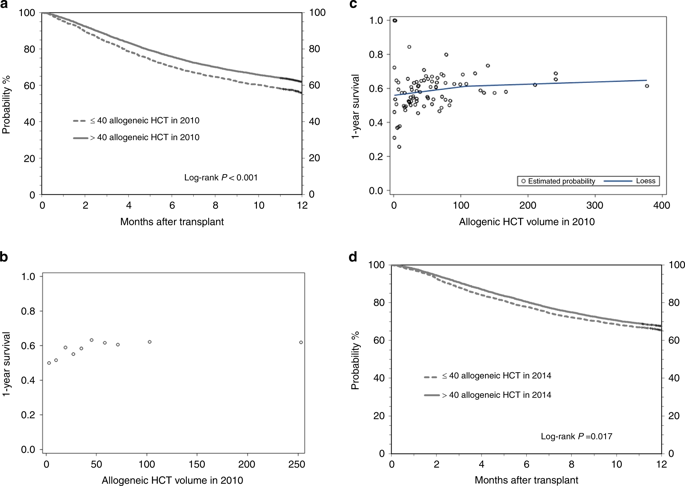当前位置:
X-MOL 学术
›
Bone Marrow Transpl.
›
论文详情
Our official English website, www.x-mol.net, welcomes your
feedback! (Note: you will need to create a separate account there.)
Transplant center characteristics and survival after allogeneic hematopoietic cell transplantation in adults.
Bone Marrow Transplantation ( IF 4.5 ) Pub Date : 2019-11-18 , DOI: 10.1038/s41409-019-0748-1 Navneet S Majhail 1 , Lih-Wen Mau 2 , Pintip Chitphakdithai 3 , Ellen M Denzen 2 , Steven Joffe 4 , Stephanie J Lee 5 , Charles F LeMaistre 6 , Fausto Loberiza 7 , Susan K Parsons 8 , Ramona Repaczki-Jones 9 , Pam Robinett 2 , J Douglas Rizzo 10 , Elizabeth Murphy 2 , Brent Logan 10 , Jennifer Le-Rademacher 11
Bone Marrow Transplantation ( IF 4.5 ) Pub Date : 2019-11-18 , DOI: 10.1038/s41409-019-0748-1 Navneet S Majhail 1 , Lih-Wen Mau 2 , Pintip Chitphakdithai 3 , Ellen M Denzen 2 , Steven Joffe 4 , Stephanie J Lee 5 , Charles F LeMaistre 6 , Fausto Loberiza 7 , Susan K Parsons 8 , Ramona Repaczki-Jones 9 , Pam Robinett 2 , J Douglas Rizzo 10 , Elizabeth Murphy 2 , Brent Logan 10 , Jennifer Le-Rademacher 11
Affiliation

|
Allogeneic hematopoietic cell transplantation (alloHCT) is a highly specialized procedure. We surveyed adult transplant centers in the United States (US) and then used data reported to the Center for International Blood and Marrow Transplant Research (CIBMTR) (2008-2010) to evaluate associations of center volume, infrastructure, and care delivery models with survival post alloHCT. Based on their 2010 alloHCT volume, centers were categorized as low-volume (≤40 alloHCTs; N = 42 centers, 1900 recipients) or high-volume (>40 alloHCTs; N = 41 centers, 9637 recipients). 100-day survival was 86% (95% CI, 85-87%) in high-volume compared with 83% (95% CI, 81-85%) in low-volume centers (difference 3%; P < 0.001). One-year survival was 62% (95% CI, 61-63%) and 56% (95% CI, 54-58%), respectively (difference 6%; P < 0.001). Logistic regression analyses adjusted for patient and center characteristics; alloHCT at high-volume centers (odds ratio [OR] 1.32; P < 0.001) and presence of a survivorship program dedicated to HCT recipients (OR 1.23; P = 0.009) were associated with favorable 1-year survival compared to low-volume centers. Similar findings were observed in a CIBMTR validation cohort (2012-2014); high-volume centers had better 1-year survival (OR 1.24, P < 0.001). Among US adult transplant centers, alloHCT at high-volume centers and at centers with survivorship programs is associated with higher 1-year survival.
中文翻译:

成人同种异体造血细胞移植后的移植中心特征和存活率。
同种异体造血细胞移植(alloHCT)是高度专业化的程序。我们调查了美国(美国)的成人移植中心,然后使用了报告给国际血液和骨髓移植研究中心(CIBMTR)(2008-2010)的数据来评估中心数量,基础设施和护理提供模式与生存率之间的关联发布aloHCT。根据2010年的alloHCT量,将中心分类为低数量(≤40个alloHCT; N = 42个中心,1900个接收者)或大容量(> 40个alloHCT; N = 41个中心,9637个接收者)。高容量患者100天生存率为86%(95%CI,85-87%),而低容量患者中心为100%(83%(95%CI,81-85%)(差异3%; P <0.001)。一年生存率分别为62%(95%CI,61-63%)和56%(95%CI,54-58%)(差异6%; P <0.001)。逻辑回归分析针对患者和中心特征进行了调整;与小批量中心相比,大批量中心的异种HCT(优势比[OR] 1.32; P <0.001)和专门针对HCT接受者的生存计划(OR 1.23; P = 0.009)与1年生存率相关。在CIBMTR验证队列(2012-2014)中观察到了类似的结果;大容量医疗中心的1年生存率更高(OR 1.24,P <0.001)。在美国成年移植中心中,高容量中心和具有生存计划的中心中的alloHCT与较高的1年生存率相关。009)与小容量中心相比,具有良好的1年生存率。在CIBMTR验证队列(2012-2014)中观察到了类似的结果;大容量医疗中心的1年生存率更高(OR 1.24,P <0.001)。在美国成年移植中心中,高容量中心和具有生存计划的中心中的alloHCT与较高的1年生存率相关。009)与小容量中心相比,具有良好的1年生存率。在CIBMTR验证队列(2012-2014)中观察到了类似的结果;大容量医疗中心的1年生存率更高(OR 1.24,P <0.001)。在美国成年移植中心中,高容量中心和具有生存计划的中心中的alloHCT与较高的1年生存率相关。
更新日期:2019-11-18
中文翻译:

成人同种异体造血细胞移植后的移植中心特征和存活率。
同种异体造血细胞移植(alloHCT)是高度专业化的程序。我们调查了美国(美国)的成人移植中心,然后使用了报告给国际血液和骨髓移植研究中心(CIBMTR)(2008-2010)的数据来评估中心数量,基础设施和护理提供模式与生存率之间的关联发布aloHCT。根据2010年的alloHCT量,将中心分类为低数量(≤40个alloHCT; N = 42个中心,1900个接收者)或大容量(> 40个alloHCT; N = 41个中心,9637个接收者)。高容量患者100天生存率为86%(95%CI,85-87%),而低容量患者中心为100%(83%(95%CI,81-85%)(差异3%; P <0.001)。一年生存率分别为62%(95%CI,61-63%)和56%(95%CI,54-58%)(差异6%; P <0.001)。逻辑回归分析针对患者和中心特征进行了调整;与小批量中心相比,大批量中心的异种HCT(优势比[OR] 1.32; P <0.001)和专门针对HCT接受者的生存计划(OR 1.23; P = 0.009)与1年生存率相关。在CIBMTR验证队列(2012-2014)中观察到了类似的结果;大容量医疗中心的1年生存率更高(OR 1.24,P <0.001)。在美国成年移植中心中,高容量中心和具有生存计划的中心中的alloHCT与较高的1年生存率相关。009)与小容量中心相比,具有良好的1年生存率。在CIBMTR验证队列(2012-2014)中观察到了类似的结果;大容量医疗中心的1年生存率更高(OR 1.24,P <0.001)。在美国成年移植中心中,高容量中心和具有生存计划的中心中的alloHCT与较高的1年生存率相关。009)与小容量中心相比,具有良好的1年生存率。在CIBMTR验证队列(2012-2014)中观察到了类似的结果;大容量医疗中心的1年生存率更高(OR 1.24,P <0.001)。在美国成年移植中心中,高容量中心和具有生存计划的中心中的alloHCT与较高的1年生存率相关。











































 京公网安备 11010802027423号
京公网安备 11010802027423号